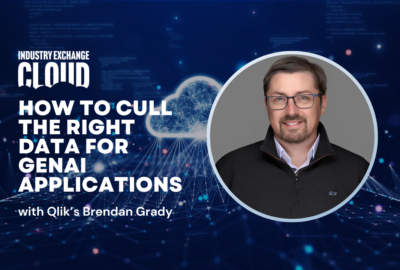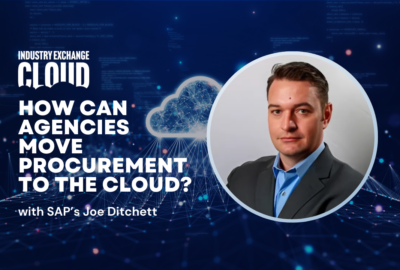Insight by Oracle
Cloud Exchange 2022: Oracle’s Mike Sicilia on how cloud can improve healthcare services
Cloud has potential to improve both patient services as well as ease the records burden on practitioners, says Oracle’s Mike Sicilia, who shares why during th...
That’s happening because moving to the cloud can break down the silos between healthcare providers and patients, said Mike Sicilia, executive vice president for Oracle Industries.
“Authentication, administration, authorization in those old technologies, some of that robust security technology doesn’t even exist. What that really leads to is even more custom and more bespoke workarounds to figure out how all of this authorization should work,” Sicilia said during the Federal News Network Cloud Exchange 2022.
“Modern cloud-based solutions can offer tremendous benefit to government because we’re able to automate these things,” he continued. “We’re also able to automate them in an auditable way, so at any given time, government and regulators, authorities that are authorized to examine these things, can come in and look at this and look at the certifications and look at the process as to how it happens.”
Increasing practitioner-friendliness
Doctors and healthcare practitioners, in some cases, spend almost twice as much time dealing with electronic health records than dealing with patients, Sicilia said. “It’s almost unimaginable to think that somebody, an end user of a system has to spend that much time dealing with the system,” he said. “The systems are not as intuitive as they should be. Frankly, we’re here to fix all that.”
The cloud allows healthcare practitioners to keep up with the pace of innovation, Sicilia said.
“If you walk into a very large medical institution today — government or private sector, really doesn’t matter — you’re likely to find very old versions of either commercial software or bespoke custom software that was created many, many years ago,” Sicilia said. “Frankly, the people that have created it may be long gone from being in the field anymore.”
The result? Systems that isolate their users and frustrate them because of the lack of automation and unease of use, he said.
“Cloud brings the ability for us to release new releases really instantly,” Sicilia said. “We’ve tested and certified the code to those end users so that they can benefit almost immediately, from the time it takes us to deliver a release.”
The fragmentation of records across multiple providers makes it hard to move records from one provider to another, especially when data sharing needs to take place across on-premise systems that often can’t interact.
“It’s often the case that the burden of moving these records around falls on the patient. Cloud-based systems, if you think about it, are the ultimate aggregator, because that integration of all those records becomes our problem at Oracle. It’s not the problem of the nation, it’s not the problem of the practitioners,” he said.
Layering in security
Cloud also enables secure access to data.
“The number of healthcare institutions that are infiltrated could be higher than anybody thinks. The security that we provide in the cloud is far more secure than IT staff at a hospital could provide, just from being able to resource this and monitor these things,” Sicilia said. “Working together with our government customers and government partners, we’re able to look at and identify these patterns of bad actors — we think quite accurately.”
Given the size of many government healthcare organizations, the move to the cloud often takes considerable time and effort.
Sicilia said that agencies sometimes opt for a “lift and shift” model of taking all existing applications and moving them to a modern cloud infrastructure. But in taking this approach, he said they don’t take advantage of software as a service cloud applications.
Modernizing processes, workflows and applications as an agency moves to the cloud is critical for long-term efficiencies, he explained. “Agencies will be able to keep pace with what our developers are releasing. If you look at the average age of applications inside agencies today, it’s certainly not measured in months, like cloud applications are,” Sicilia said.
Sicilia said agencies should also anticipate training needs for their employees as they implement cloud solutions.
“In the old days, when you re-implemented applications, there was a big training aspect. This is one of the actual deterrents from customers moving from older versions of applications to newer versions of applications. When you make the first leap from an existing legacy application to a new cloud application, there might be a little bit of training involved, but certainly not orders of magnitude because these systems are designed to be modern and intuitive,” he said.
In a cloud environment, training becomes incremental. Users learn about small features as they’re developed on a regular basis, Sicilia said. “The training efforts go drastically down. So the productivity of your workforce should go up as a result because you don’t have these big moments in time where you’re re-implementing something. That’s an old way of doing things.”
Oracle expands healthcare capabilities through Cerner acquisition
In June, Oracle completed the acquisition of Cerner, one of the leading electronic medical records (EMR) vendors in the world.
“So far, so good,” said Oracle’s Mike Sicilia. He noted that the people who have joined Oracle have extensive clinical and institutional knowledge.
“We believe that the partnering of all that intellectual property, all of that know-how, and our modern cloud application infrastructure and application technologies will really provide great outcomes.”
Check out all the sessions from the Federal News Network Cloud Exchange 2022.
Copyright © 2024 Federal News Network. All rights reserved. This website is not intended for users located within the European Economic Area.
Related Stories
Protected: Industry Exchange Cloud 2024: SAP’s Joe Ditchett on how agencies can move procurement to the cloud
VA approach to automated software testing is rooted in flexibility and efficiency
Featured speakers
-

Mike Sicilia
Executive Vice President, Oracle Industries
-

Jory Heckman
Reporter, Federal News Network
Upcoming Events
Related Stories
Top Stories

Mike Sicilia
Executive Vice President, Oracle Industries

Jory Heckman
Reporter, Federal News Network






